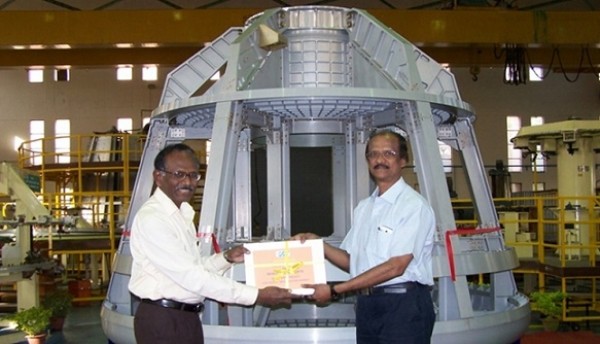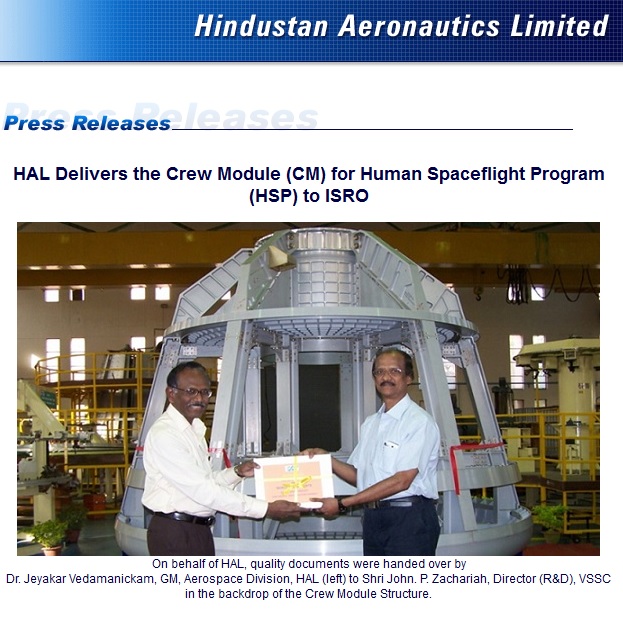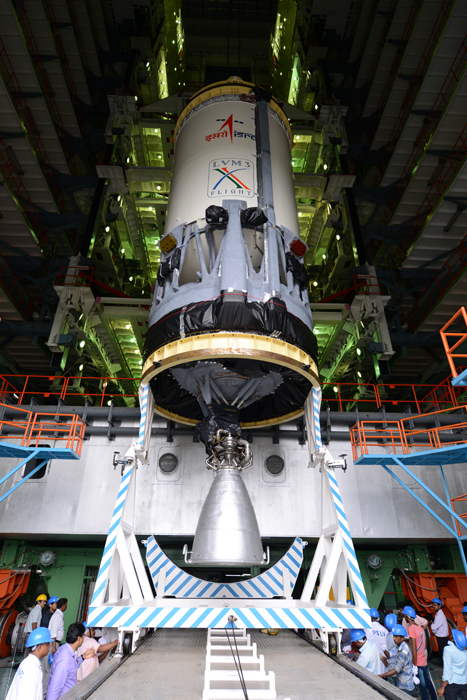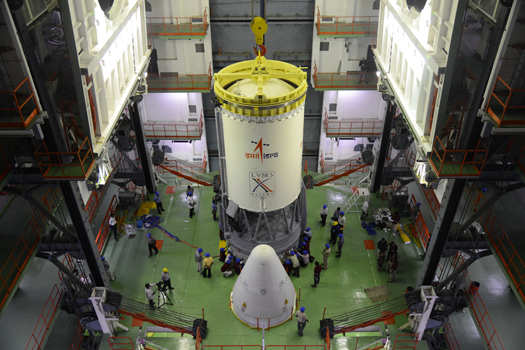ISRO is inching closer to launch its ambitious human space mission with the first experimental unmanned flight of the crew module on the newly developed Geosynchronous Satellite Launch Vehicle (GSLV) Mark III in May-June from Sriharikota, said Dr K Radhakrishnan, chairman ISRO and secretary, Department of Space. The GSLV-MK-III is being developed as a heavy-lift vehicle capable of placing satellites weighing up to 5,000 kg in geosynchronous orbit.
“The experimental flight of GSLV Mark-III with a passive cryo stage will be flown to study the performance of the launch vehicle. This opportunity is used to study the re-entry characteristics of crew module,” Dr Radhakrishnan who was here for launching of Village Resource Centre of ISRO in Puducherry, told Express.
Speaking about the manned mission, Dr Radhakrishnan said “Currently no programme has been fixed for the manned mission. We are studying the critical new technologies for subsystems such as crew module, environmental control and life support system, for undertaking the manned mission.” The mission envisages carrying two or three crew members on the crew module to about 300 km low earth orbit and their safe return to a predefined destination on earth.
Quelle: THE INDIAN EXPRESS
.
Update: 2.03.2014
.
India unveils its own astronaut crew capsule, plans test launch

India, hoping to become the fourth nation to send humans into space, has unveiled a key element in the effort, an indigenously manufactured astronaut capsule.
The country's space agency has displayed a prototype of its first crew capsule module designed to carry two people into low Earth orbit, ScienceInsider reported.
The Indian Space Research Organization announced plans to send the test prototype into orbit with the first experimental flight of the country's latest rocket, the Geosynchronous Satellite Launch Vehicle Mark III..
Capable of putting 10 tons of payload into a low-Earth orbit, it could launch in May or June from Sriharikota spaceport on the coast of the Bay of Bengal, the agency said.
Currently only the United States, Russia and China have accomplished the feat of putting humans into Earth orbit.
The Indian space agency said it has decided on the test flight even though the government has yet to grant approval and funding for a human space-flight program.
"We thought it better to [go ahead to] gain some confidence in the design of our crew module," said Sundaram Ramakrishnan, director of ISRO's Vikram Sarabhai Space Center in Thiruvananthapuram, Kerala.
The capsule, manufactured by Hindustan Aeronautics Limited, is intended to carry two or three astronauts into a low-Earth orbit on a weeklong mission.
Quelle: UPI
.
Update: 25.11.2014
.
All set to put unmanned crew module into orbit

ISRO’s unmanned crew module undergoing tests at the Vikram Sarabhai Space Centre, Thiruvananthapuram. The maiden flight of GSLVMark III in December 2014 will put the unmanned crew module in the orbit.
.
There is frenetic activity at Sriharikota for the maiden lift-off of India’s newest and the biggest launch vehicle in December, which will put an unmanned crew module into orbit.
The mission is a stepping stone to the Indian Space Research Organisation (ISRO) ultimately sending astronauts into space in the module.
The 3.65-tonne module will get de-mated from the topmost cryogenic stage at an altitude of 125 km and return to the earth. At an altitude of 15 km, there will be an “aerial ballet,” featuring three huge parachutes which will open up one after the other to slow down the module’s descent. The module is expected to splash down in the sea near the Andaman archipelago and will be recovered by the Indian Coast Guard and ISRO personnel. The entire flight from the lift-off to the splash-down will last about 20 minutes. It is a passive, experimental and sub-orbital mission.
ISRO Chairman K. Radhakrishnan said, “Everything is progressing well” for the GSLV-MkIII launch in December. The rocket weighs 630 tonnes and is 42.4 metres tall.
“We are ready. Everything is pucca,” said M.C. Dathan, Director, Vikram Sarabhai Space Centre (VSSC), Thiruvananthapuram, which has built both the GSLV-MKIII and the unmanned crew module. Two gigantic strap-on motors, each of which will use 200 tonnes of solid propellants, have been strapped around the core stage in the second launch pad. The core stage will use 110 tonnes of liquid propellants. Above the core stage is the cryogenic stage. The module will be “encapsulated” with the cryogenic stage on November 26, said Mr. Dathan.
S. Somanath, Project Director, GSLV-MKIII, called it India’s “biggest, heaviest and the next generation” launch vehicle.
Quelle: The Hindu
.
Update: 30.11.2014
.
ISRO to launch GSLV Mark III between Dec 15 and 20

Isro’s (Indian Space Research Organisation) crew module or CARE, which would be launched in an experimental mission from Satish Dhawan Space Centre at Sriharikota between December 15 and 20. (Photo: PTI)
.
Inching towards its human space programme, India would test a crew module recovery experiment even as it would study the vehicular performance of its latest Geosynchronous Satellite Launch Vehicle (GSLV - Mark III) from Satish Dhawan Space Centre here between December 15 and 20. "ISRO would launch its heaviest rocket GSLV-Mark III (LVM 3 X mission) sometime between December 15 and 20. The rocket would also carry a crew module to test its re-entry characteristics," MYS Prasad, Director, Satish Dhawan Space Centre, told reporters here.
The launch intends to test the atmospheric characteristics and stability of the updated rocket on its way up and would study the crew module on its re-entry into the atmosphere. While the rocket would cost Rs 140 crore, the crew module would cost Rs 15 crore, he said.
Elaborating on the updated GSLV Mark III, S Somanath, Project Director, GSLV Mark III, said, "The rocket can carry upto four tonne payload. This is the heaviest rocket India has ever launched. It is 630 tonne at lift off. We would test only the first two stages and not the cryogenic stage." "The cryogenic engine is under development and it will take more two years to be ready," said Prasad.
Since Indian government has not officially approved sending humans into space so far, Prasad said the crew module would not carry any living being and it is only for study purposes. Explaining the process, Project Director of Crew Module, S Unnikrishnan Nair, said after getting separated from the rocket around 126 km, it would be stabilised by thrusters designed on board. "The three tonne weighing crew module would use four set of parachutes to safely land on the surface of the sea at 7 metre per second. It will land some 180 km from Indira Point of Andaman and Nicobar Islands. From the lift off to the crew module splashing into the sea, it will take around 20 minutes," he said. The cup cake-shaped crew module is 2.5 metre tall and 3.5 metre in diameter, he said.
The capsule, tentatively designed to carry three astronauts, would be recovered by Indian Coast Guard ships. A practice of the recovery was done on October 31 with Coast Guard ship ICGS Samudra Paheredar, he added.
Quelle:dna
-
To put man in space, Isro to test crew module in December
Scientists at the Satish Dhawan Space Centre in Sriharikota are busy integrating a brown bucket-like structure with a black lid mounted on a pedestal. Some day soon, they believe, an improved version of this would carry human beings to space.
Indian Space Research Organisation (Isro) is taking baby steps towards sending man to space, with an experimental flight of a GSLV-Mark III all set to carry this 'crew module' as the payload in the second week of December. While the manned mission is at least 10 years away, a full-fledged flight of GSLV-MIII is still a couple of years away. The biggest rocket ever to be made by Isro, it can carry payloads up to four tones—a necessity in the coming days of heavy communication satellites.
For this, scientists are testing the indigenously developed cryogenic engine at Isro's Mahendragiri facility in Tirunelveli district. In the experimental flight called the LVM3-X/CARE mission, the cryogenic engine C25 will not be used.
"We will be having a morning launch for the experimental test flight on any day between December 15 and 20. The date will be finalized in another week," said SHAR director M Y S Prasad. The unmanned module to be used in Crew Module Atmospheric Re-entry Experiment (CARE) is to test the ability of the module to re-enter the Earth's atmosphere with thermal resistance, parachute deployment in cluster formation, aero braking system and apex cover separation procedures.
The crew module will be separated from the GSLV rocket at an altitude of 126km and will re-enter the atmosphere at about 80km. It will 'soft-crash' into the Bay of Bengal about 600km from Port Blair, and be retrieved by the Indian Coast Guard tracking its beacon signal. This will be the first time the module weighing more than 3,000kg will be tested for its atmospheric reentry and parachute deployment patterns from such high altitudes. Isro's first space recovery experiment (SRE-1) module launched by a PSLV in January 2007 weighed just 555kg, and it was not a crew module. It re-entered atmosphere and was successfully collected from the Bay of Bengal.
"We will not be injecting any object into the orbit during this test flight. The crew module costs around Rs 15 crore and Rs 140 crore was spent on the GSLV Mark III components to be used for the test flight," said project director S Somanath.
CARE mission director Unnikrishnan Nair said so far the crew module has been tested by airdropping it from IAF choppers and the test flight will provide them a chance to actually map its trajectory, thermo resistance capacity of the exterior. The module will be packed with three separate sets of parachutes to be deployed in pairs, including a 31-metre diameter parachute which will be the biggest made in the country. Experts pointed out that manned missions in the future will involve similar crew modules, but with special chambers for life support.
Quelle: The Times of India
.
Update: 8.12.2014
.
Wenn Frauen sich bei Raketentechnik auszeichnen!

In this file photo, ISRO scientists monitor the Mars Orbiter Mission in the ISRO Telemetry, Tracking and Command Network (ISTRAC) Mission Operations Complex at Peenya in Bengaluru. Photo: K. Murali Kumar
.
These scientists have played a key role in designing GSLV Mk-III
Women can’t be left out when the Indian Space Research Organisation (ISRO) launches yet another dream: sending astronauts into space.
In fact, women scientists and engineers have played a key role in designing the Geo-synchronous Satellite Launch Vehicle-Mark III that will lift off from Sriharikota in a few days, carrying a crew capsule without astronauts.
As it is only an experimental mission, the capsule will return 20 minutes after the blast-off.
“The development of the GSLV Mk-III (LVM3) started in 2002. Then on, many women have played different roles in the project,” says S. Somanath, its project director, as he showed the crew module at the Satish Dhawan Space Centre (SHAR) at Sriharikota.
There are many noteworthy women among the 600 engineers at the Vikram Sarabhai Space Centre (VSSC), the Liquid Propulsion Systems Centre and the SHAR who developed the rocket in phases.
The digital auto pilot (DAP), the software that controls the rocket, was designed by V.R. Lalithambika and her team. D.S. Sheela is the group director; V. Brinda is the head of the Control Design Division; and Manju Unnikrishnan and Rani designed the onboard software and its integration.
The simulation of the flight of LVM3 requires special software. S. Anitha, A. Sreelatha and Jayachithara are among the seniors who worked on the software.
B. Valsa is an expert in software engineering and deputy director responsible for the system reliability of the VSSC. “She and her team, comprising 200 engineers and other technical staff, are responsible for the quality and reliability of the systems as well as testing,” says Mr. Somanath.
“On an average, 40-50 women would have worked in different phases of this project… They have proved that they are equally competent when compared with their male counterparts,” he emphasises.
Structural designer A.P. Beena, along with her young colleague Geethu Abraham and others, designed the Crew Module Atmospheric Re-entry Experiment (CARE) structure for this mission. “Beena has designed the propellant tanks of the L110 stage of LVM3,” Mr. Somanath notes.
Rachel SKD, a veteran in structural design, has earlier designed many structures of the PSLV and the GSLV. For LVM3, she and her colleagues have designed the most critical structures, very complex in design.
“At every juncture of this project, women scientist have added value [to it] and given us ideas and inputs. R. Neetha is head of the Structural Dynamics Division, which is responsible for evaluating the rocket structures to dynamic loading. They carry out response studies to find out whether the vibration levels in rocket while in flight is within the specified limits,” Mr. Somanath says.
There is a younger crop of scientists and engineers, too. Many women engineers who joined in recent years from the premier institutes in the country are working on the assembly and testing of the rocket system, at test stands and in the vehicle launch complex as engineers.
Once the GSLV Mark III’s capsule, the size of a small bedroom, returns to earth with the help of three large parachutes, these women scientists, along with their male colleagues at the ISRO, will begin building on yet another complex, but cherished, dream — India’s Human Space Flight Programme.
Quelle: The Hindu
.
Update: 10.12.2014
.
Isro to test GSLV Mk-III, crew module on December 18
MUMBAI: India's manned space flight programme will move a step forward with the much-awaited launch of the advanced Geo-Synchronous Satellite Launch Vehicle (GSLV-MIII) on December 18 between 9am and 12pm from Sriharikota.
The mission has evoked global interest because its only payload is the unmanned Crew Module Atmospheric Re-entry Experiment.
After the Mars mission, the GSLV Mark-III flight is considered the next important step in India's nearly 50-year-old space programme.
Speaking to TOI on Tuesday, GSLV Mark-III project director S Somanath said the primary aim of the first flight is to test the new rocket which has the capability to carry four-tonne class Insat-series communication satellites that are currently being flown by Arianespace.
Somanath said that 325 seconds after the lift off, the crew module — made of aluminium alloy and with a lift-off mass of 3,735kg — will separate from the rocket at an altitude of 126km. Three different types of parachutes tested at facilities in Chandigarh and at Sriharikota by dropping them from a helicopter will be deployed during the descent. About 1,280 seconds after the launch the module will splashdown in the Bay of Bengal at a point 600km from Port Blair. It will be recovered by the Indian Coast Guard.
Somanath said that the module has an ablative thermal protection system because during re-entry into the atmosphere, it will experience heat around 1,600 degrees C.
Quelle: THE TIMES OF INDIA
.
First experimental suborbital flight of India's latest generation Launch Vehicle- GSLV Mk-III, carrying Crew Module Atmospheric Re-entry Experiment (CARE) is scheduled in the third week of December 2014 from SDSC SHAR

The two S200 Strap-ons during the integration of the vehicle

L110 Liquid Core Stage being prepared at Stage Preparation Facility

The partially integrated vehicle with S200 Strap-ons and L110 Core Stage outside the Vehicle Assembly Building
The passive C25 Cryogenic Upper Stage being hoisted at Vehicle Assembly Building
Integration of the passive C25 Cryogenic Upper Stage with L110 liquid Core Stage in Progress at Vehicle Assembly Building
CARE at clean room before its launch
GSLV Mk-III mock-up at Second Launch Pad
Quelle: ISRO
.
Update: 15.12.2014
.
Launch rehearsal of ISRO’s LVM 3 successful

Indian Space Research Organisation (ISRO) would launch a crew module on board LVM 3 in an experimental mission from Satish Dhawan Space Centre at Sriharikota between December 2nd and 3rd Week 2014
.
Ahead of the country’s maiden experimental launch of latest generation vehicle GSLV Mk III, which would carry out the ‘Crew module Atmospheric Re- entry Experiment (CARE) on a suborbital mission on December 18, ISRO successfully carried out a rehearsal on Monday.
“The nine hour 30 minutes launch rehearsal of ISRO LVM3 has just been successfully completed,” ISRO said in its social networking site.
Confirming the success, a senior ISRO official said the countdown for the launch of GSLV Mk III/X CARE Mission (also known as LMV 3) would commence around 8.30 a.m., on December 17 at Sriharikota.
Asked about the reason behind the lesser duration of countdown, he said it was a 24-hour countdown before the December 18 launch since the mission would carry only a dummy cryogenic stage.
“The countdown would be for around 24 hours and would commence around 8.30 a.m., on December 17. The lift off of the launch has been scheduled at 9 a.m., on December 18,” he told PTI.
The 630-tonne GSLV-Mk III would carry the 3.65 tonne crew module even as the national space agency is equipping itself for its ambition of sending astronauts into space eventually.
However, the Indian government has not approved any human mission to space presently.
Realisation of 42.4 metre tall GSLV Mk-III would help ISRO place heavier satellites into orbit.
GSLV Mk III is conceived and designed to make ISRO fully self reliant in launching heavier communication satellites of INSAT-4 class, which weigh 4,500 to 5,000 kg.
It would also enhance India’s capability to be a competitive player in the multi-million dollar commercial launch market.
Quelle: The Hindu
.
Update: 17.12.2014
.
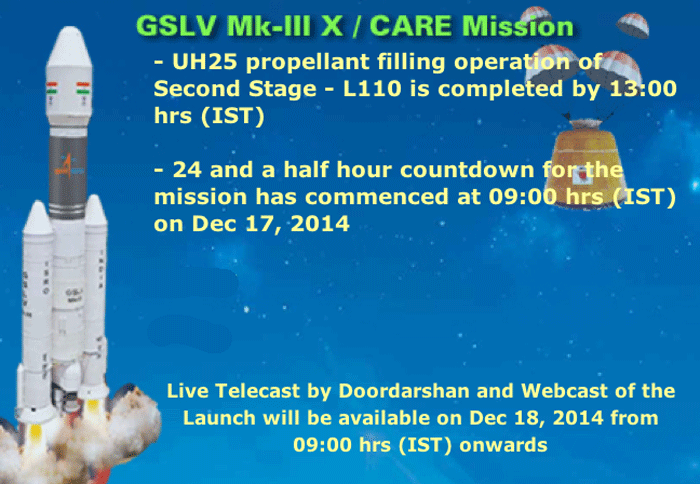
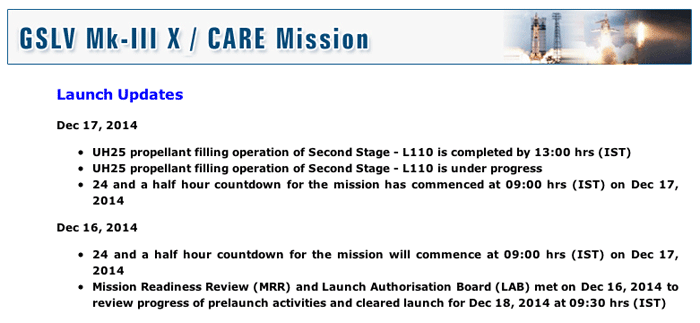
-

Quelle: ISRO
.
Update: 18.12.2014 / 7.55 MEZ
.
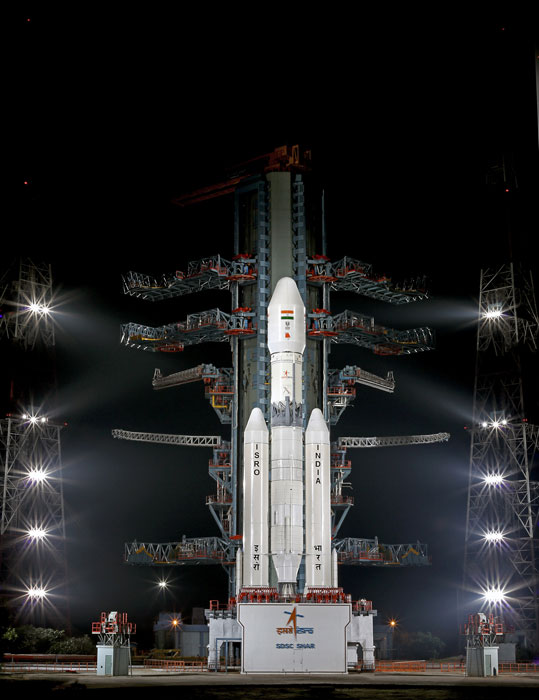
.


Quelle: NDTV
.
ISRO rocket GSLV Mark-III successfully launched; PM Modi says yet another triumph of brilliance
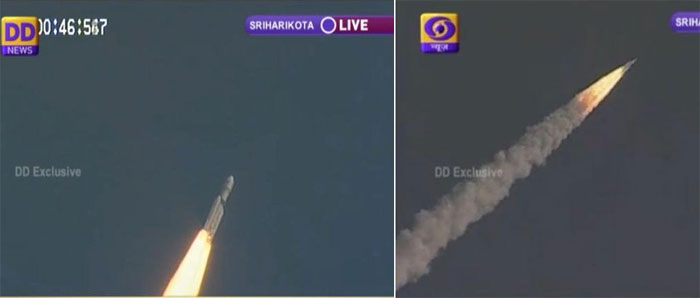


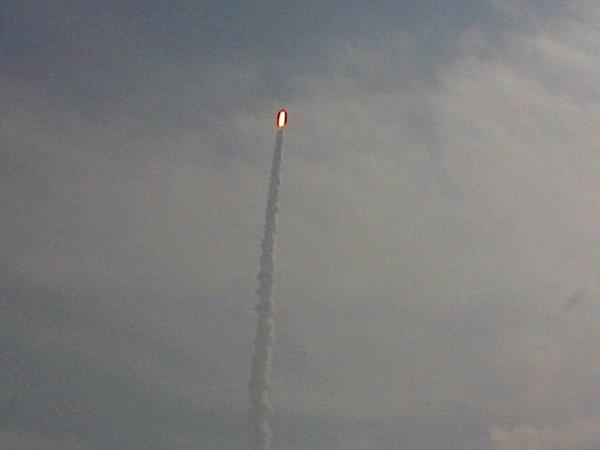




Quelle: 2-News
...Update: 10.00 MEZ





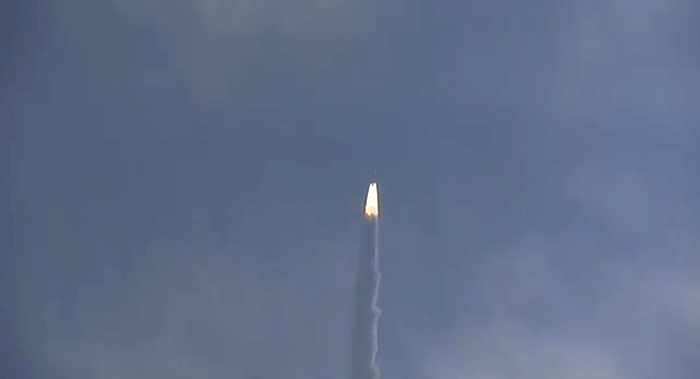


Quelle: ISRO
... Update 11.50 MEZ
First Experimental Flight of India's Next Generation Launch Vehicle GSLV Mk-III Successful
The first experimental flight (GSLV Mk-III X/CARE) of India's next generation launch vehicle GSLV Mk-III was successfully conducted today (December 18, 2014) morning from Satish Dhawan Space Centre SHAR, Sriharikota. Also known as LVM3-X/CARE, this suborbital experimental mission was intended to test the vehicle performance during the critical atmospheric phase of its flight and thus carried a passive (non-functional) cryogenic upper stage.
The mission began with the launch of GSLV Mk-III at 9:30 am IST from the Second Launch Pad as scheduled and about five and a half minutes later, carried its payload - the 3775 kg Crew Module Atmospheric Re-entry Experiment (CARE) - to the intended height of 126 km. Following this, CARE separated from the upper stage of GSLV Mk-III and re-entered the atmosphere and safely landed over Bay of Bengal with the help of its parachutes about 20 minutes 43 seconds after lift-off.
Two massive S-200 solid strap-on boosters, each carrying 207 tons of solid propellants, ignited at vehicle lift-off and after functioning normally, separated 153.5 seconds later. L110 liquid stage ignited 120 seconds after lift-off, while S200s were still functioning, and carried forward for the next 204.6 seconds.
CARE separated from the passive C25 cryogenic upper stage of GSLV Mk-III 330.8 seconds after lift-off and began its guided descent for atmospheric re-entry.
After the successful re-entry phase, CARE module's parachutes opened, following which it gently landed over Andaman Sea about 1600 km from Sriharikota, there by successfully concluding the GSLV Mk-III X/CARE mission.
With today's successful GSLV Mk-III X / CARE mission, the vehicle has moved a step closer to its first developmental flight with the functional C25 cryogenic upper stage.
.
.
Quelle: ISRO
... Update 20.20 MEZ
.
Crew Module floating in the Andaman Sea after splash down
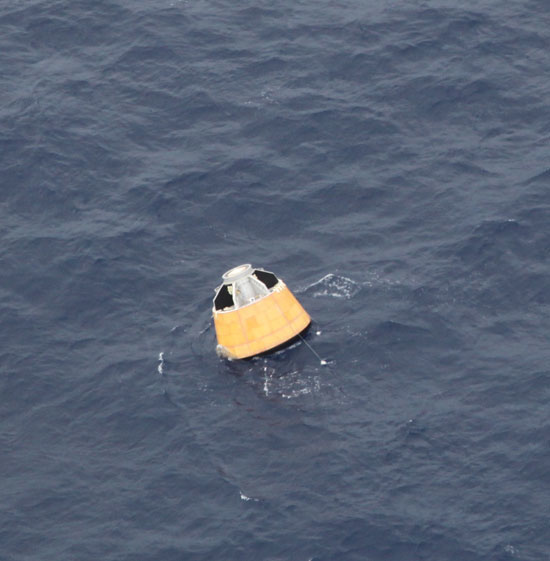
.
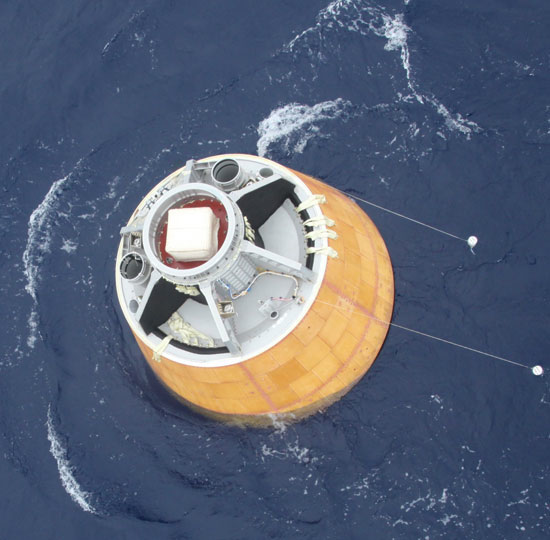
.

Quelle: ISRO
.
Update: 20.12.2014
.
CARE module during recovery process by the Coast Guard team after reentry
.
.
.
.
Quelle: ISRO
.
Update: 17.01.2015
.
Prototype of Crew Capsule for Manned Missions Back Home

THIRUVANANTHAPURAM: The crew module is back home. The prototype of the crew capsule for future manned missions to space which the Indian Space Research Organisation (ISRO) successfully tested in December arrived here on Friday morning.
Over the next few months, the cupcake-shaped module would undergo tests before being put on display at the Space Museum at Vikram Sarabhai Space Centre (VSSC), Thumba.
The dummy module was more or less built at the VSSC. While its basic structure was designed by Hindustan Aeronautics Ltd (HAL), the VSSC had been responsible for its integration and ‘arming’ it with heat shields and control and guidance mechanisms.
The Crew Module Atmospheric Re-entry Experiment (CARE) had been the sole payload aboard the sub-orbital test-flight of the Geosynchronous Satellite Launch Vehicle Mk-III (GSLV Mk-III) which lifted off from Sriharikota on December 18, 2014.
CARE was dropped back to earth from a height of 126 km and recovered by the Indian Coast Guard from the Bay of Bengal. After arriving at the Kamarajar Port, Ennore, on December 21, it was taken straight to Sriharikota. “The module arrived here on Friday morning,” VSSC director M Chandradathan said. “During the next several months, ISRO scientists will subject it to comprehensive tests,” S Unnikrishnan Nair, CARE payload director, said. “The tests will go on for around six months. After that it will be displayed at the museum,” he said. ISRO is also likely to put it in on a public exhibition here as it had done with the Space Capsule Recovery Experiment-1 (SRE-1) module in 2007.
The then ISRO chairman K Radhakrishnan receiving the crew module from Coast Guard officials after recovery from the Bay of Bengal on December 18, 2014.
Quelle: The Indian Express
